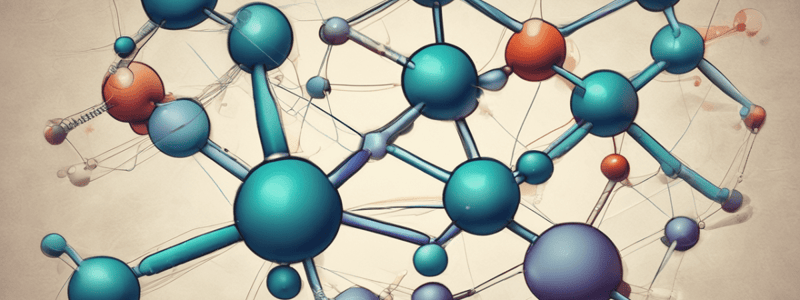Podcast
Questions and Answers
What is the general formula for the alkene family?
What is the general formula for the alkene family?
- CnH2n (correct)
- CnH2n-1
- CnH2n-2
- CnH2n+1
What is the distinguishing feature of the alkene structure?
What is the distinguishing feature of the alkene structure?
- Carbon-hydrogen bond
- Carbon-carbon triple bond
- Carbon-carbon single bond
- Carbon-carbon double bond (correct)
What is the strongest bond in the carbon-carbon double bond?
What is the strongest bond in the carbon-carbon double bond?
- π bond
- σ bond (correct)
- Hydrogen-hydrogen bond
- Carbon-hydrogen bond
What is the name of the simplest member of the alkene family?
What is the name of the simplest member of the alkene family?
According to the IUPAC system, what is the parent structure of an alkene named?
According to the IUPAC system, what is the parent structure of an alkene named?
What is the ending of the alkane name changed to when naming an alkene?
What is the ending of the alkane name changed to when naming an alkene?
How is the position of a double bond designated in an alkene?
How is the position of a double bond designated in an alkene?
What takes precedence over alkyl groups and halogens in determining the main carbon chain and the direction in which it is numbered?
What takes precedence over alkyl groups and halogens in determining the main carbon chain and the direction in which it is numbered?
What is a characteristic of the physical properties of alkenes?
What is a characteristic of the physical properties of alkenes?
What is the reason for cis, trans isomerism in alkenes?
What is the reason for cis, trans isomerism in alkenes?
What is the difference between cis-2-butene and trans-2-butene?
What is the difference between cis-2-butene and trans-2-butene?
Why are cis-2-butene and trans-2-butene different compounds?
Why are cis-2-butene and trans-2-butene different compounds?
What is the process of converting alkyl halides into alkenes?
What is the process of converting alkyl halides into alkenes?
What is the primary product when sec-Butyl chloride undergoes dehydrohalogenation?
What is the primary product when sec-Butyl chloride undergoes dehydrohalogenation?
What is the role of the hydroxide ion in the dehydrohalogenation mechanism?
What is the role of the hydroxide ion in the dehydrohalogenation mechanism?
What is the difference between the breaking of C-H and C-X bonds in dehydrohalogenation?
What is the difference between the breaking of C-H and C-X bonds in dehydrohalogenation?
What is the general formula for alcohols?
What is the general formula for alcohols?
What is the second method of preparing alkenes mentioned in the text?
What is the second method of preparing alkenes mentioned in the text?
What is required for dehydration to occur?
What is required for dehydration to occur?
What is the role of alumina in dehydration?
What is the role of alumina in dehydration?
What is a Lewis acid?
What is a Lewis acid?
What is the first step in the mechanism of dehydration of alcohols?
What is the first step in the mechanism of dehydration of alcohols?
What is lost in the second step of the dehydration mechanism?
What is lost in the second step of the dehydration mechanism?
What is the final product of the dehydration mechanism?
What is the final product of the dehydration mechanism?
What is the driving force behind the rearrangement of a carbonium ion?
What is the driving force behind the rearrangement of a carbonium ion?
What is the result of the dehalogenation of vicinal dihalides?
What is the result of the dehalogenation of vicinal dihalides?
What is the type of migration where a hydrogen atom moves with a pair of electrons?
What is the type of migration where a hydrogen atom moves with a pair of electrons?
What is the outcome of the reduction of an alkyne to the double-bond stage?
What is the outcome of the reduction of an alkyne to the double-bond stage?
Why does the 3,3-dimethyl-2-butyl cation rearrange to the 2,3-dimethyl-2-butyl cation?
Why does the 3,3-dimethyl-2-butyl cation rearrange to the 2,3-dimethyl-2-butyl cation?
Which type of carbonium ion is the most stable?
Which type of carbonium ion is the most stable?
A carbonium ion can rearrange to form a less stable carbonium ion.
A carbonium ion can rearrange to form a less stable carbonium ion.
The dehalogenation of vicinal dihalides is a method for the synthesis of alkanes.
The dehalogenation of vicinal dihalides is a method for the synthesis of alkanes.
A hydride shift is a migration of an alkyl group with a pair of electrons.
A hydride shift is a migration of an alkyl group with a pair of electrons.
Reduction of an alkyne can yield only a cis-alkene.
Reduction of an alkyne can yield only a cis-alkene.
The 2-methyl-1-butyl cation rearranges to the 2-methyl-2-butyl cation.
The 2-methyl-1-butyl cation rearranges to the 2-methyl-2-butyl cation.
Alkyl halides can be converted into alkanes through dehydrohalogenation.
Alkyl halides can be converted into alkanes through dehydrohalogenation.
The 3,3-dimethyl-2-butyl cation rearranges to the 2,3-dimethyl-1-butyl cation.
The 3,3-dimethyl-2-butyl cation rearranges to the 2,3-dimethyl-1-butyl cation.
Isomeric alkenes can be formed in the dehalogenation of vicinal dihalides.
Isomeric alkenes can be formed in the dehalogenation of vicinal dihalides.
Tertiary carbonium ions are less stable than primary carbonium ions.
Tertiary carbonium ions are less stable than primary carbonium ions.
An alkyl shift is a migration of hydrogen with a pair of electrons.
An alkyl shift is a migration of hydrogen with a pair of electrons.
Flashcards
Alkene Definition
Alkene Definition
Unsaturated hydrocarbons with a carbon-carbon double bond and the general formula CnH2n.
Ethylene
Ethylene
The simplest alkene, having the formula C2H4.
Carbon-Carbon Double Bond
Carbon-Carbon Double Bond
A bond formed by sharing two pairs of electrons between two carbon atoms, consisting of a strong sigma (σ) bond and a weaker pi (π) bond.
IUPAC Naming Rules (Alkenes)
IUPAC Naming Rules (Alkenes)
Signup and view all the flashcards
Cis-Trans Isomerism
Cis-Trans Isomerism
Signup and view all the flashcards
Cis-2-Butene
Cis-2-Butene
Signup and view all the flashcards
Trans-2-Butene
Trans-2-Butene
Signup and view all the flashcards
Dehydrohalogenation
Dehydrohalogenation
Signup and view all the flashcards
Dehydration of Alcohols
Dehydration of Alcohols
Signup and view all the flashcards
Vicinal Dihalides
Vicinal Dihalides
Signup and view all the flashcards
Reduction of Alkynes
Reduction of Alkynes
Signup and view all the flashcards
Physical Properties (Alkenes)
Physical Properties (Alkenes)
Signup and view all the flashcards
Study Notes
Alkenes
- Alkenes are unsaturated hydrocarbons with the general formula CnH2n.
- The simplest alkene is ethylene, C2H4.
- Alkenes have a carbon-carbon double bond, which is made up of a strong σ bond and a weak π bond.
- The C─C distance in ethylene is less than in ethane, and the double bond is shorter than the carbon-carbon single bond.
Names of Alkenes
- Common names are rarely used, except for three simple alkenes: ethylene, propylene, and isobutylene.
- Most alkenes are named by the IUPAC system.
- The IUPAC system rules:
- Select the longest continuous chain that contains the carbon-carbon double bond as the parent structure.
- Indicate the position of the double bond in the parent chain by a number.
- Carbon-carbon double bonds take precedence over alkyl groups and halogens in determining the main carbon chain and direction.
Physical Properties
- Alkenes possess physical properties similar to those of alkanes.
- They are insoluble in water, but soluble in nonpolar solvents like benzene, ether, and chloroform.
- Boiling point rises with increasing carbon number.
Cis, Trans Isomerism
- Alkenes show cis, trans isomerism due to restricted rotation about the carbon-carbon double bond.
- Example: 2-butene has two stereoisomers, cis-2-butene and trans-2-butene.
- These compounds cannot be converted into each other at room temperature and have different physical and chemical properties.
Preparation of Alkenes
-
- Dehydrohalogenation of alkyl halides:
- Alkyl halides are converted into alkenes by elimination of hydrogen halide.
- Dehydrohalogenation involves removal of the halogen atom and a hydrogen atom from a carbon adjacent to the one bearing the halogen.
-
- Dehydration of alcohols:
- Alcohols are compounds of the general formula ROH.
- Dehydration requires the presence of an acid and heat.
- Mechanism involves the formation of a protonated alcohol, dissociation into water and a carbonium ion, and the loss of a hydrogen ion to form the alkene.
-
- Dehalogenation of vicinal dihalides:
- Vicinal dihalides are compounds that have halogens on adjacent carbons.
- They are prepared by the reaction between a halogen and an alkene.
-
- Reduction of alkynes:
- Reduction of an alkyne to the double-bond stage can yield either a cis-alkene or a trans-alkene.
- The choice of reducing agent determines which isomer predominates, except when the triple bond is at the end of a chain.
Studying That Suits You
Use AI to generate personalized quizzes and flashcards to suit your learning preferences.




